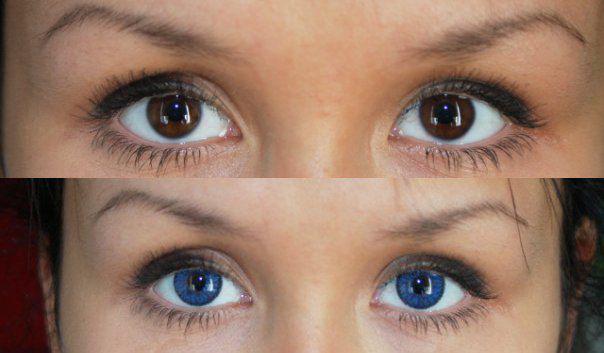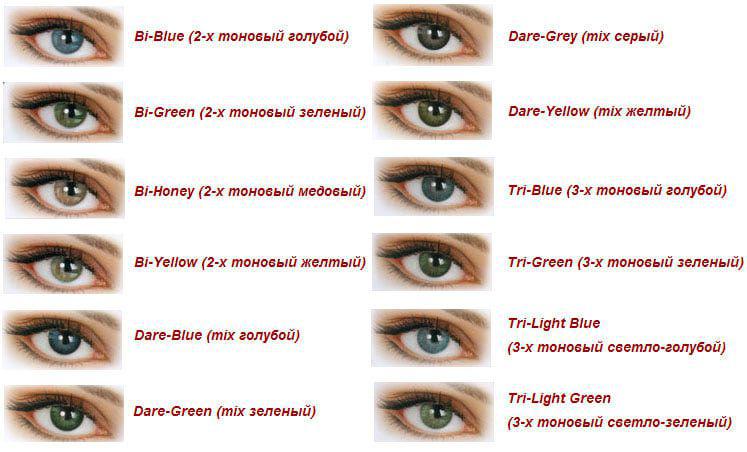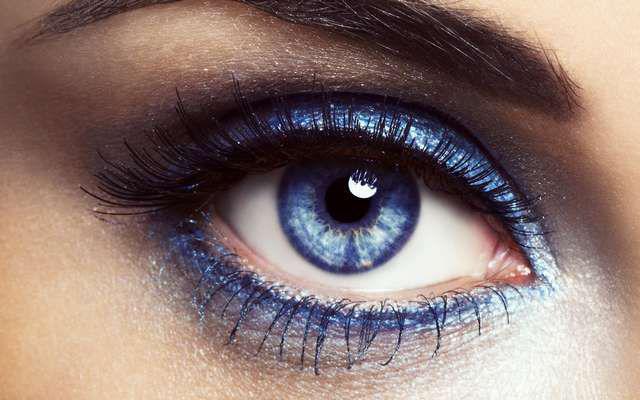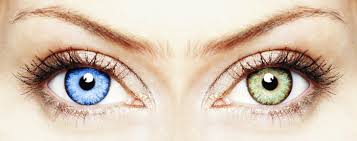beautiful, expressive, bright eyes always draw attention to the person. Alas, nature has not endowed each of us with such a look that can delight others. For this reason, many young people seek to change the color of their eyes or make them brighter. Today, this has become possible thanks to colored contact lenses. Modern capable of strengthening and radically changing natural color eyes, as well as to give them uniqueness in the form of an original and bright pattern on the iris.
The blue color is created by a layer behind the iris and its reflection when light falls. On one side, there is a coating on the back of the iris, the pigment epithelium, while on the other, the iris contains a cloudy, colorless substance, the stroma. If a white light appears on a liquid, it does not look colorless, but blue. . Incident light is scattered and reflected, in particular, by components of the short-wavelength blue light - as a result, the eyes appear blue.
After birth, most fair-skinned babies have Blue eyes. Where: In fact, the iris is quite colorless to blue-white on closer inspection. Melanin is hardly present in newborns - as a result, falling light rays are also mostly rejected by the short wavelength components of blue light. Only from the sixth month of life, children receive correct color eyes if there is increased melanin production.
Lenses for changing the color of the eyes are a very relevant accessory for our days. They can be used by anyone who wants to temporarily change the color of their eyes. And this desire does not depend on whether or not a person needs vision correction.
Initially, they had an even, solid color, not similar to the natural color of the eyes. Modern colored and tinted lenses are as close as possible to the natural color of the iris human eye. Today there are several varieties of such lenses:
Although most children with blue eyes come into the world, this is not the most dominant eye color. Brown iris is widely used, with approximately 90 percent of the world's population. In the dominant, green and finally blue follow. By the way, the researchers found that the color of the blue eye itself is a mutation. It probably originated around 000,000 years ago. When the activity of the gene involved in the formation of brown pigment is inhibited, melanin turns brown to blue. In addition, this is a fundamental mutation - all people with blue eyes get from the person who first suffered this mutation.
- Actually called colored contact lenses designed to radically change the natural color of light or dark eyes. These lenses are the most common. They are coated with a dye that does not let light through. The pupil area in them remains absolutely transparent.
- Tinted lenses have only a slight tint (20%) and cannot drastically change the color of the eyes. They are designed to partially change natural color eyes or giving them more bright shade. Tinted lenses are acceptable only for people with light eyes, but they are not able to influence dark eyes.
- Decorative lenses are designed for those who want to stand out from the crowd. With their help, fancy patterns and color effects are created on the iris of the eye. A person in decorative lenses will never go unnoticed.
- Carnival lenses are a kind of decorative lenses. But unlike the previous ones, they create a very catchy, sometimes unexpected and even shocking pattern on the iris of the eye (vampire eye, emoticon, dollar sign, cat eye, thorn, soccer ball, flames, etc.) Carnival lenses are mainly used by young people on theme parties and carnivals. IN Everyday life wearing them is not recommended, so as not to shock others.
- Cosmetic lenses are called contact lenses used to hide eye defects. They are used by patients with eye defects such as:
- aniridia(absence of the iris);
- anisocoria(pupils of different sizes);
- aphakia(lack of lens);
- heterochromia(eyes of different colors);
- coloboma(lack of part of the iris);
- thorn(partial clouding of the cornea of the eye), etc.
 Lenses that hide pupil defects
Lenses that hide pupil defects Cosmetic colored lenses are available in two varieties:
Our genes determine eye color
Blue eyes are more common in the Baltics and Scandinavia. In contrast, newborns are often born with brown eyes in Asian, Hispanic, and African countries. This is probably due to the fact that melanin is already formed in the mother's body. Eye color is genetic, color dominance plays important role. For example, parents with blue and brown eyes are dominated by brown, the more dominant color. However, in heredity, one more factor must be taken into account: it is assumed that more than one gene is responsible for eye color, but not all of them have yet been deciphered.
- translucent tinted;
- opaque.
Translucent tinted lenses allow you to see the natural color of the eyes. The effect of these lenses depends on the color of the iris and on the color of the lenses themselves.
Opaque colored lenses are designed to drastically change the color of the eyes. These lenses replace the iris as the reflection surface, and the color of the reflected light is determined by the dyes used. The desired color or pattern is superimposed on an opaque surface. These lenses can be used to change the color of both light and dark eyes.
One gene consists of two alleles, each of which gives parents only one allele. That is, if the father has, for example, Brown eyes, it can have either the blue or brown allele. However, for his child, he only passes on one allele - and it doesn't have to be the dominant color. Thus, the child does not have to inherit the father's brown eyes, but may also get blue eyes.
How mutations change eye color
It is important to know what eye color a baby will get shortly after birth: especially bright blue eyes usually stay blue, while blue eyes tend to brown later on. Rainbow skin is not always the same color. In so-called iris heterochromism, iridescent skins are pigmented differently in the same individual, resulting in different colored eyes. However, this form is relatively rare in humans, and animals such as dogs or cats are much more commonly affected.
Many users are concerned about the safety of the dye used on colored contact lenses. I would like to reassure potential wearers of colored lenses: the dye of most modern lenses is inside them and does not come into contact with the surface of the eyes and eyelids.
Colored lenses allow you to correct and (hypermetropia) in a wide range optical power(in most cases from +6 diopters to -6 diopters). In specialized laboratories, you can order colored lenses designed to correct more complex types of ametropia or refractive error:
Partial iridescent heterochromism is again different from iris heterochromism. This means a partial disturbance and causes a different coloration in only one eye: for example, an additional Brown color may appear in blue eye. Both phenomena can be obtained both by congenital and, for example, by inflammatory changes.
Other, not everyday form is albinism. The gene defect is characterized by the absence of pigment cells. Not only does the skin appear matte white in people with albinism, but the eyes also appear light pink and pink. Due to the lack of pigments, light penetrates into blood vessels eyes - as a result, the iris appears pink.
- toric colored lenses (for astigmatism correction);
- multifocal colored or tinted lenses ().

There are also lenses designed for reusable use. The first ones are very convenient for those who prefer to change the color of their eyes from time to time, for some special occasions. Also, one-day colored lenses allow you to experiment with colors, changing them daily. But colored lenses of prolonged wear (that is, those that can be worn for several days or weeks without removing) do not exist. The fact is that conventional continuous-wear contact lenses are made of silicone hydrogel, which is able to pass oxygen to the cornea of the eye. In colored lenses, the oxygen transmission rate is very low (20-25 units), which is the norm exclusively for daily wear.
Colored contact lenses in the poultry industry are available in all possible colors. Our colorful contact lenses help transform your personal eye color. Just decide to change the type and color of colored lenses. They are easy to use and therefore ideal for daily use as well as for a special occasion.
Colorful contact lenses for a radiant and captivating glow!
Do you want your eye color to sparkle or surprise your friends with a special surprise at your next party? Our high quality colored lenses allow you to completely and naturally transform your eyes with unique beautiful flowers. Collection of new colored contact lenses.
Some colored lenses contain a UV filter to protect your eyes from UV rays.
Key Rule choosing colored lenses: always proceed from the natural color of your eyes. In the description of the lenses, you can read information about what type of eyes they are intended for: for dark or light. There are also universal lenses: they are suitable for eyes of any color.
Benefits of our premium lenses at a glance. Now you can admire your unique eye color and try how you can transform! Appearance of our exclusive lenses is unique, giving your eyes a brilliant and captivating color that still looks very natural.
General information about colored contact lenses
All of our lenses maintain high quality standards and are therefore very well tolerated by the eyes. It comes with all possible colors, gray contact lenses, blue contact lenses, green contact lenses, brown contact lenses or crazy contact lenses, as well as colorful contact lenses.
If you have light eyes you'd be better off using tinted lenses. If you are the owner of dark eyes and want to make the color lighter, buy lenses with a dense pattern.
See if the lenses of one color or another suit you. To do this, it is recommended to use special programs and services that allow you to upload your photo and “try on” several lens options. It is important that colored lenses not only cover the color of the eyes, but also match the color of the skin and hair.
The color of confidence with colored contact lenses!
Really crazy how beautiful the eyes are and the color of the old eye is covered. I don't like my sleepy eyes and now it looks really cool! Thank you for joining the party! Even if you are not part of any trend, with colored contact lenses you can change your type. If you're looking for an alternative to your everyday look, try colored contact lenses. But also for aesthetic reasons, such as an accident that damaged the iris, colored contact lenses are suitable for upgrading one's own optics.

How to wear these lenses
All contact lenses must be worn correctly. Familiarize yourself with the rules of proper wearing of colored contact lenses:
- Apply makeup after wearing lenses;
- Do not wear colored or tinted lenses for more than 8 - 12 hours (according to the instructions), especially do not sleep in them, otherwise your eyes will turn red and watery.
- Before going to bed, remove the lenses, rinse and put in a container with a special solution.
- Strictly adhere to the instructions that come with the lenses, and the terms of their use.
- Even if you have good vision, before buying colored lenses consult . Despite the fact that the lenses are safe for health, there are some contraindications.
- Don't let other people try your lenses on. This is a personal hygiene item.
![]()
Pleasant wearing comfort thanks to optimal craftsmanship
To make sure you also really enjoy colored contact lenses, they are made to the highest standards. high standards quality. It is especially important that the lenses have a high water content so that they can be worn better. Lentils that are not certified can cause serious damage to your eyes. You should also pay attention to the diameter of the contact lenses. Most lenses are made for European eyes. Many colored contact lenses are offered without durability. Therefore, they are not suitable for compensating for visual impairment.
- If you buy colored lenses for special event, do this a few days before it, so that your eyes get used to it and you feel comfortable. Indeed, at first, the effect of "fogging" can be observed.
The fact that colored lenses harm the eyes is just a myth. The layer that colors the eye is located inside the hydrogel lens and does not come into contact with the eyes. If you follow the above rules, you will receive only positive emotions from wearing colored lenses.
However, the owners of the spectacle do not need to do without interesting lenses. The effect also comes at a cost. Good colored contact lenses can be used for 12 months, provided careful care. Therefore, be sure to buy a product for proper care.
Blue contact lenses or gray contact lenses?
In addition to colored contact lenses, there are also interesting lenses. Whether it is the eye of a cat or the eye of a wolf, the possibilities are manifold. With contact lenses, you can optically change according to your wishes. Create A New Look just a few steps or find a party at the party. Colored contact lenses or crazy contact lenses make you unique. Your environment will lead you to another if you suddenly ask for a favor with seductive cat eyes. Gray contact lenses, blue contact lenses, green contact lenses and brown contact lenses are also suitable for office use.
Precisely predict how a particular shade of lenses will be combined with natural color eye, difficult. Below are a few important recommendations, which will help you navigate the selection of colored contact lenses.
- The darker natural shade eye, the more difficult it is to radically “lighten” it. To do this, choose contact lenses with a dense color and pattern.
- If you choose a shade that is different from yours, then keep in mind the following fact: when applying two various shades it might be the third one.
- To enhance the natural color, use tinted translucent contact lenses. On the eyes they look the most natural.
- Each manufacturer of colored lenses, and each of their series, has its own pattern. If a pattern seems rough or unnatural to you, try picking up lenses from another collection.
Video
https://youtu.be/B5oPoUlBkfo
However, you should avoid crazy contact lenses and colorful contact lenses in the office. If you're not celebrating carnival with your co-workers, you'll appreciate colored contact lenses with confidence. Whether you choose green contact lenses, brown contact lenses, or even colorful contact lenses is entirely up to your taste. The reasons why people want to change their eye color are varied. Some find their own eye color boring or want a richer color.
Others would like to change their iris colors with clothing and hair coloring or would like to put a striking or startling look on a special case. Regardless of the reasons, today almost all forms of shape and color can be realized cost-effectively with non-strength colored contact lenses.
conclusions
They are very popular today, because. people love the before and after results. The ability to change the color of your eyes, depending on your mood, attracts many. So, you can change the color of the eyes in accordance with the clothes, the weather, with the created image, every time you go out. These lenses do not require maintenance. special attention and they are quite affordable. But most importantly - absolutely safe when correct wearing. So go ahead: change your image up to a cardinal change in eye color!
Enhancement of the natural color of the eyes should be the most common task of colored contact lenses worn in everyday life. For example, his Blue colour may be more radiant due to the more intense coloration of the lenses. Or create interesting shades original color through a rather greenish lens. Even the individual expression of the eye can be enhanced or enhanced, for example by including contrasting colors. They make the iris more interesting.
Generally, bright eyes are easier to change with colored or tinted lenses than dark eyes. But even in very dark eyes amazing can be achieved, meanwhile some manufacturers offer unusually natural blue lenses for dark brown eyes. And for the very brave, there are still contact lenses in extravagant colors, such as purple, that don't meet in the eyes.
I think that almost every person is dissatisfied with something in their appearance and wants to change it. This is especially true for women. If the hair is naturally straight, then we want wavy, if the eyes are brown, we want blue. Now all this is not a problem. The hairdresser will help you change your hairstyle, and the optician will help you change the color of your eyes. Perhaps the most accessible and practically safe way change the image - change the color of the eyes with the help of colored contact lenses. Colored contact lenses will undoubtedly provide you with the attention of others. After all, the eyes are the first thing they pay attention to.
They use effects that have also proven their worth in cosmetics and make-up. Dark borders allow color to shine brightly, and intentionally placed color accents make surfaces more interesting. Especially shown here are the so-called round lenses, what is possible. These cosmetic contact lenses are no bigger than regular lenses but have a clear aperture ring on the outside, mostly in dark or black. As a result, the eyes appear optically larger than without a lens, they can act as Round eyes dolls.
Party, carnival and halloween with different eyes
This trend originated in South Korea, Japan and Taiwan, and now it has spread all over the world. It is very suitable for cosplay and manga. You can buy Circle lenses online at low prices. At all events and festivals where a veneer is required, powerless colored contact lenses are almost fashionable.
Who can wear colored lenses? Yes, almost everyone. And even for those who have visual impairments, such as myopia, farsightedness, astigmatism, etc. There are corrective lenses - for people with poor vision and without diopters - for those who have good eyesight.
In general, colored contact lenses are divided into four groups.
- With indicator color. These are lenses, usually with diopters, that are slightly colored. This was done on purpose to make them easier to find in a disinfectant solution, easier to take off and put on. Such lenses do not change the color of the eyes, perhaps, they only make the eyes a little brighter, especially light ones.
- Tinted lenses. Such lenses are colored evenly, but the iris is visible through the dye. They enhance the natural color of the eyes, so they are best suited for those people who have light eyes. On dark eyes, the effect will not be visible.
- Color contact lenses. These lenses drastically change color, regardless of eye color. They are also called cosmetic, because they help hide eye defects such as cataracts, cataracts, etc. Such lenses are applied with a complex pattern that mimics the iris. In order not to change the color rendition, the central part, where the pupil is located, is not stained.
- Crazy - lenses. A type of colored contact lens that can either give you a cat's eye or leave you with only pupils. There are a lot of options for such lenses, you can choose to your liking. These lenses are usually purchased as part of a carnival costume, and usually they are one time only.
 The dye that is used for lenses is harmless to the eyes, it has been tested more than a dozen times. In addition, it does not come into contact with the eyes, because it is located in the central layer of the lens. But due to the intensity of the dye, some problems may arise. Everyone knows that depending on the lighting, the pupil narrows or expands. When the pupil is dilated, it becomes wider than the uncolored area, then there is a feeling that the vision has deteriorated. In addition, if the lens does not fit tightly on the eye, it can move, then the colored area can fall on the pupil, and the same sensation will appear again. In this situation, tinted lenses win because they are lightly tinted and almost transparent.
The dye that is used for lenses is harmless to the eyes, it has been tested more than a dozen times. In addition, it does not come into contact with the eyes, because it is located in the central layer of the lens. But due to the intensity of the dye, some problems may arise. Everyone knows that depending on the lighting, the pupil narrows or expands. When the pupil is dilated, it becomes wider than the uncolored area, then there is a feeling that the vision has deteriorated. In addition, if the lens does not fit tightly on the eye, it can move, then the colored area can fall on the pupil, and the same sensation will appear again. In this situation, tinted lenses win because they are lightly tinted and almost transparent.
Caring for colored lenses the same as for ordinary ones. They must be stored in a container with disinfectant solution to be changed every day, cleaned thoroughly after use. Colored lenses are not intended for long-term wear, they can be in the eyes for a maximum of 8 hours, in no case should you sleep in them, because they let in a minimum of oxygen. If you notice damage, then such a lens should not be worn so as not to damage the eye and not to cause an infection. It is necessary to select colored lenses only with the help of an ophthalmologist and after a thorough examination, as there are contraindications for wearing such lenses.














